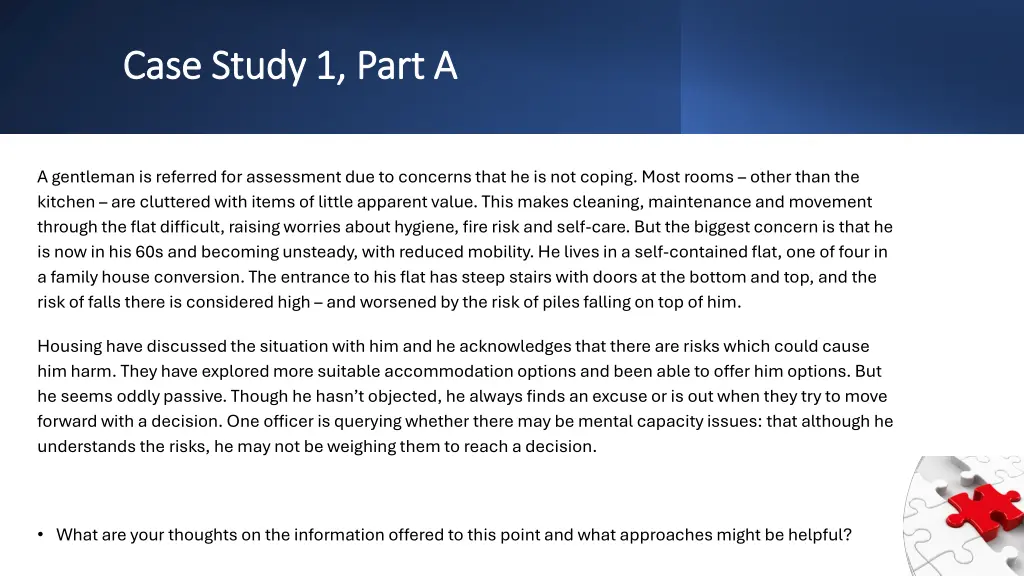
Understanding Complex Care Needs in Individuals
Delve into real-life case studies of individuals facing significant challenges in coping with daily life, from cluttered living spaces to neglecting health and safety concerns. Explore the complexities of mental capacity, decision-making, and support strategies in these scenarios to enhance understanding and promote effective interventions.
Download Presentation

Please find below an Image/Link to download the presentation.
The content on the website is provided AS IS for your information and personal use only. It may not be sold, licensed, or shared on other websites without obtaining consent from the author. If you encounter any issues during the download, it is possible that the publisher has removed the file from their server.
You are allowed to download the files provided on this website for personal or commercial use, subject to the condition that they are used lawfully. All files are the property of their respective owners.
The content on the website is provided AS IS for your information and personal use only. It may not be sold, licensed, or shared on other websites without obtaining consent from the author.
E N D
Presentation Transcript
Case Study 1, Part A Case Study 1, Part A A gentleman is referred for assessment due to concerns that he is not coping. Most rooms other than the kitchen are cluttered with items of little apparent value. This makes cleaning, maintenance and movement through the flat difficult, raising worries about hygiene, fire risk and self-care. But the biggest concern is that he is now in his 60s and becoming unsteady, with reduced mobility. He lives in a self-contained flat, one of four in a family house conversion. The entrance to his flat has steep stairs with doors at the bottom and top, and the risk of falls there is considered high and worsened by the risk of piles falling on top of him. Housing have discussed the situation with him and he acknowledges that there are risks which could cause him harm. They have explored more suitable accommodation options and been able to offer him options. But he seems oddly passive. Though he hasn t objected, he always finds an excuse or is out when they try to move forward with a decision. One officer is querying whether there may be mental capacity issues: that although he understands the risks, he may not be weighing them to reach a decision. What are your thoughts on the information offered to this point and what approaches might be helpful?
Case Study 2, Part A Case Study 2, Part A Mr G neglects his health, putting him at risk of diabetic complications, and is often found sleeping rough alongside friends of his, though he has his own flat. At these times, he tends to drink significant amounts of alcohol; he used to get into fights when drinking that led to at least three hospital admissions for head injury. The flat itself is deteriorating and he is at risk of losing his tenancy. Professionals have assessed his mental capacity to make the relevant decisions, and he seems able to understand and talk through the risks he is running. Each time he says that he understands the consequences of his actions and assures them apparently earnestly that he will stop sleeping on the street, not invite people in, address fire risks, and engage in self-care. Each time he does not follow through. Professionals are puzzled and growing increasingly concerned and frustrated about the likelihood he will come to harm. Questions to Consider: What different explanations might there be for the discrepancy between what Mr G says and what he does? How might you work together to explore each of them?
Case Study 3, Part A Case Study 3, Part A Mr H is a man in his early twenties, living alone in an apartment since he left his mother s house three years ago. Neighbours, who had moved in some months before, raised concerns about the state of the property. When the council contacted him about his obligations, it was observed that the flat was dirty and highly cluttered. Mr H looked underweight and exhausted, and avoided eye contact, yet appeared emotionally flat. He repeated himself several times during the conversation but did not give a clear explanation for the situation. The worker tried to explore with him what options there were and asked if he needed support, but he grew more and more tense, muttered I don t know, then broke off the conversation abruptly. Follow-up attempts to contact him were unsuccessful, and he rarely seemed to be at the flat. Questions to Consider: How many possible factors can you think of that might be contributing to this situation, and how might you explore them? What do you think services would be most likely to do next?
Case Study 4, Part A Case Study 4, Part A Ms B, recently retired, has lived with Mr A since he moved in with her a few years ago. She has an adult son nearby, but they are not in contact; this upsets her and she attributes it to tensions between him and Mr A. The community nursing team have now visited Ms B at home, due to concerns that she is showing signs of slight cognitive impairment. They were startled by the levels of clutter in the housewhich have appeared in the last few years they reach 7 on the Clutter Rating Scale and leave little space to move around in. The objects include several old typewriters, newspapers and jottings, broken tools, DIY scraps, and even an old lawnmower. Ms B is vague about when they got these items, what they are and why they are being kept. The nurses offer to refer for a fire safety assessment, which Ms B accepts. The officers discuss the significant risks with her and she seems to accept the risks, but says, Oh, I couldn t get rid of these things! She does not seem to know what many of them are and admits she has never used most of them. What are your thoughts on the information so far, and what would be your next steps?
Responding to trauma caused by Responding to trauma caused by services services Listen. Listen. You know when somebody's telling you they're not well, it's not pissed off or having a bad day. They're not well. You know when somebody opens their heart and says, well, I don't feel right. Some interviewees told us about how they had been affected by professionals not believing them about health conditions or a disability. That experience could lead to distrust or hopelessness. Questions for consideration: How do you consider and address that, whether you are from the same service or a different one?






















